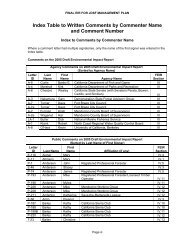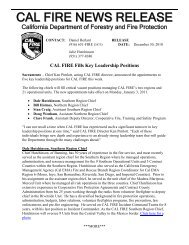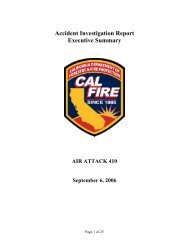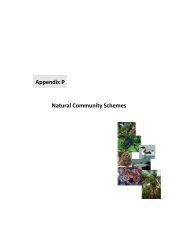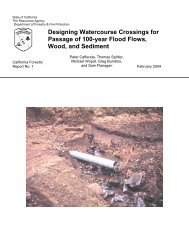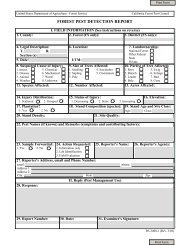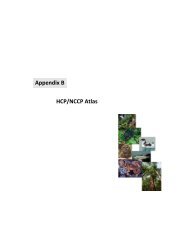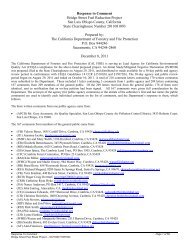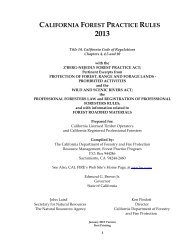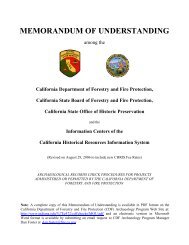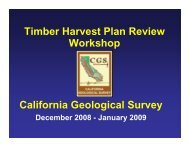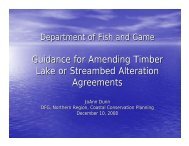Boggs Mountain Demonstration State Forest Draft ... - Cal Fire
Boggs Mountain Demonstration State Forest Draft ... - Cal Fire
Boggs Mountain Demonstration State Forest Draft ... - Cal Fire
Create successful ePaper yourself
Turn your PDF publications into a flip-book with our unique Google optimized e-Paper software.
<strong>Boggs</strong> <strong>Mountain</strong> <strong>Demonstration</strong> <strong>State</strong> <strong>Forest</strong> <strong>Draft</strong> Management Plan, June 2008<br />
the small number of local loggers in business (and available for salvage sales) it may be in the<br />
<strong>State</strong>’s interest to award a Class I sale without a competitive bid.<br />
Logs may be purchased from the <strong>State</strong> <strong>Forest</strong>, subject to permit constraints and applicable state<br />
regulations. Payments are generally made on the basis of log volume removed from the <strong>State</strong><br />
<strong>Forest</strong>. The purchaser is responsible for paying all applicable yield and sales taxes. The removal<br />
of timber requires the purchaser to be in possession of a valid timber operator’s license. Prices<br />
for logs to be removed are subject to negotiation between the purchaser and the <strong>State</strong> <strong>Forest</strong><br />
manager. All timber operations are limited by the <strong>Forest</strong> Practice Rules and constraints<br />
established by the <strong>State</strong> <strong>Forest</strong> manager. Logging requires a THP approved by CAL FIRE.<br />
Typical <strong>State</strong> <strong>Forest</strong> constraints include provisions for protection zones for watercourses, slope<br />
limitations, wet weather restrictions, and pre-location of yarding and hauling facilities. Trees must<br />
not exhibit signs of active nests.<br />
Minor <strong>Forest</strong> Products:<br />
BMDSF offers the public and private commercial interests the opportunity to purchase minor<br />
forest products, subject to specific rules and constraints. Permits can be purchased for collection<br />
of products including salvage sawlogs, poles, split products, greenery (e.g. boughs, shrubs, and<br />
ferns), rocks, and firewood. Class I sale permits are issued for the collection of these minor forest<br />
products. Payment is made on an item or volume basis and the purchaser is responsible for<br />
payment of all applicable taxes.<br />
Harvesting Methods<br />
Tractor yarding is appropriate for BMDSF since over 95 percent of the timberland on the forest is<br />
under 50 percent slope and has an existing tractor road network in place from past harvesting<br />
operations. Rubber tired skidders, forwarders, and track laying equipment may be utilized over<br />
most of the forest. Areas with slopes over 65 percent are small and reachable with a tractor long<br />
line; however cable and/or helicopter yarding systems may be used when economically feasible.<br />
Horse logging has been done primarily for research and demonstration purposes and may be<br />
used again in the future.<br />
Carbon Sequestration and Greenhouse Gas Emissions<br />
In 2007 the <strong>State</strong> of <strong>Cal</strong>ifornia passed the Global Warming Solutions Act (AB 32), which set<br />
targets to reduce greenhouse gas emissions to 1990 levels by 2020 and 80 percent below 1990<br />
levels by 2050. The <strong>Cal</strong>ifornia Air Resources Board was tasked with obtaining compliance with<br />
the cap through regulatory and market approaches. Planning is currently underway and definitive<br />
decisions by the Board have not yet been taken, however, it appears that forests will play a<br />
significant role in non-regulated strategies to meet targets. This is anticipated to occur both as<br />
offsets within a cap and trade system and through voluntary measures.<br />
Recognized strategies to mitigate Greenhouse Gas Emissions (GHG emissions) and enhance<br />
terrestrial sequestration include reforestation, forest management, and fuels treatments to avoid<br />
catastrophic losses. BMDSF will contribute to the targets of AB 32 by increasing the resiliency of<br />
the <strong>Forest</strong> to catastrophic mortality by improving the general health of stands, pre-fire<br />
implementation of a shaded fuel break, and maintenance of firefighting infrastructure such as<br />
roads, signage, and water sources. The long-term carbon stocks of the <strong>Forest</strong> are projected to<br />
increase over time. For example, the Option A Plan projects that the timber inventory on the<br />
<strong>Forest</strong> will increase from 14,500 board feet per acre in 2008 to about 25,000 board feet per acre<br />
in 2108.<br />
<strong>Forest</strong> products produced from BMDSF will sequester carbon during their life cycle. We anticipate<br />
being able to significantly increase the level of carbon sequestration at <strong>Boggs</strong> <strong>Mountain</strong> by<br />
increasing the productivity and yield of the stands on the <strong>Forest</strong> using the silvicultural methods in<br />
31



